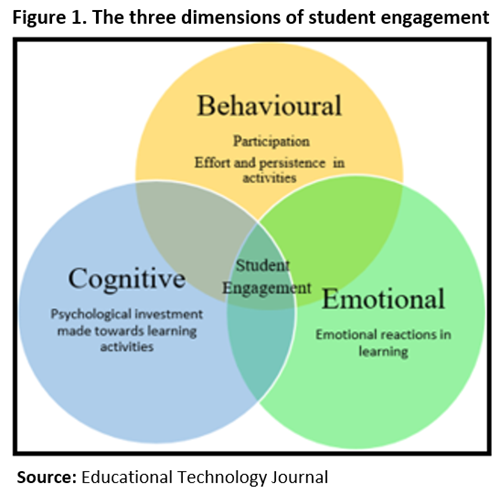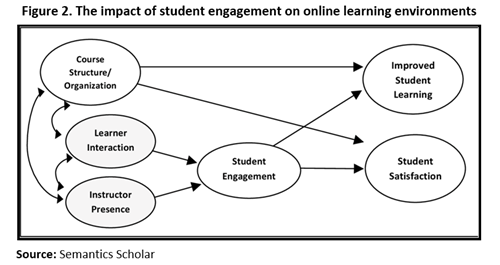ABSTRACT
The unprecedented COVID-19 pandemic transformed the higher education landscape drastically - online education replaced the traditional face-to-face mode and became the new normal. Along with this transformation in educational practices, a concern for impending changes to pedagogy to suit a new delivery method emerged, with an emphasis on maintaining and enhancing student engagement.
INTRODUCTION
Student engagement is a concept that has become increasingly important in educational research, particularly as higher education has embraced an alternative digital format. It can be described as the degree of attention, effort, curiosity, interest, optimism, motivation, and passion that students display during the learning process, which is influenced by their interactions with the learning environment, learning activities, and relationships with peers and academic staff. It is a term ‘usually used to represent constructs such as quality of effort and involvement in productive learning activities’ (Kuh, 2009). The more engaged and interested students are in the content or a lesson, the more motivated they are to improve their learning and achieve the required learning outcomes. Motivation is a term that appears frequently in the literature on student engagement and is often used interchangeably with engagement. However, motivation is an ‘antecedent’ of engagement (Bond & Bedenlier, 2019; 2007; Singh et al., 2022), and is viewed as a personal characteristic. Two distinct dimensions of motivation are essential to the broader discussion around engagement: intrinsic motivation, which is driven by internal rewards - such as students who learn because they have a genuine interest in a topic; and extrinsic motivation, which is driven by external. tangible rewards - such as students who complete assignments for good grades.
THE COMPONENTS OF STUDENT ENGAGEMENT
Influenced by multiple factors, student engagement is a topic that is highly contested, extensively researched and as a construct is dynamic, complex, and multi-faceted (Trowler & Trowler, 2010). The interrelated components of student engagement are widely debated, with social engagement suggested as a fourth component (Bond et al., 2020), described as the interaction between students and their peers, and between teaching staff and students. Emotional or affective engagement is a component that involves the connection students feel with a learning activity and their level of interest and enjoyment in that activity. Cognitive engagement is a component that describes the problem-solving and critical thinking skills students employ to understand a concept. Behavioural engagement is a component that illustrates the effort and participation levels of students and their commitment to learning activities. Further research examining possible changes that may occur in the dimensions of engagement of students in face-to-face classes compared with students in online classes would provide useful and interesting insights for academic staff and other stakeholders in the sector.

The increased emphasis on student engagement since the onset of the pandemic is largely due to the distinct differences between traditional face-to-face and online learning environments. While there are benefits to online learning such as the flexibility it offers students and the convenience at which they can access content and classes, a limitation in recent years has been the sense of isolation that students feel from their peers and lecturers when pursuing studies online. This is a factor that often drives low levels of engagement and progression and subsequent high levels of attrition. Online learning environments lack two essential features that were previously believed to address and influence highly engaged students: the face-to-face interaction with lecturers and other students; and the ability of lecturers to observe, in a face-to-face setting, students engaging with learning activities and content.

Other factors that may impact engagement in online educational environments are access to the required technology and stable internet connectivity, the quality of online content, the abilities and skills levels of faculty to effectively teach in online environments, students’ confidence and proficiency in using technology, and the availability of consistent and reliable technical support from the institution. These factors all create heightened levels of anxiety for students and a reduced interest and commitment to learning and the learning outcomes (Bond & Bedenlier, 2019; Northey et al., 2018), which may impede student engagement levels.
At the start of the pandemic, when education worldwide was disrupted and subsequently moved online, the emergency response from faculty and institutions was to replicate the face-to-face classes in an online setting. This was not effective or sustainable long-term. A fundamental change in the approach to teaching was required, to ensure that students continued to attend classes, learn, and stay engaged. Online courses were gaining popularity before the pandemic, so there was a host of available educational and multimedia resources for online teaching and prior research from faculty who had some experience with online teaching. However, faculty had to abruptly morph into online lecturers, which posed numerous challenges, especially in cases where institutions were not structured adequately with high quality online material to support online courses, or there was inadequate training and support provided to lecturers from institutions. This rapid transition meant learning new skills and being adept at technology while facing other significant changes such as new forms of assessment that had to be restructured to suit an online mode of delivery. In some cases, a complete redesign of the course had to be considered, with project-based assessments added. Some institutions introduced remote proctoring software for summative assessments, but these were not suitable for all disciplines. The modifications to course and assessment design had to be implemented in line with rapidly changing institutional policies and directives. Throughout the process of these significant adjustments, international students in particular, were plunged into greater unease and uncertainty.
Further to this, many international higher education students in Australia returned to their home countries during the pandemic and faced additional challenges such as having to adapt to attending live classes in different time zones, a sudden shift to online support from institutions, a lack of stable internet connectivity and appropriate technology, and the additional stressor of the COVID-19 pandemic creating instability, uncertainty, and apprehension for how the remainder of their studies would unfold. For students that remained onshore, the financial hardships they faced due to employment losses (with a knock-on impact on living expenses) and a lack of adequate financial support from government contributed to their anxiety. These factors played a crucial role in the motivation and engagement levels of students as they adjusted to navigating a new online learning space.
While there is substantial research in the area of student engagement in higher education, there is a deficiency in research specific to the engagement levels of international higher education students and their unique challenges, such as succeeding at studies in a new country while adapting to new academic settings and environments, a different society, culture, and language, and living away from their support networks such as family and friends. The adjustment to new societal and cultural norms, living arrangements and support systems can contribute to additional stress, which affect engagement levels and study success. The higher education industry (HEI) in Australia needs to drive change in the way the sector addresses engagement levels with this specific cohort of students, as low engagement levels affect other key areas in the industry, such as progression and attrition rates. This is especially critical for Australian HEIs now, due to the significant global competition for the recruitment of international students post pandemic. Australia must acknowledge the importance of establishing and providing sufficient resources and support services for international students in online or hybrid settings, since these contribute to positive experiences and help attract and retain international students.
CONCLUSIONS
International students’ expectations and perceptions of higher education have changed and continue to change as technology advances and reshapes teaching and learning in HEIs. As online education becomes more prevalent (including in a hybrid format), other accessible forms of education to support lifelong learning’ (Beech & Anseel, 2020, p. 448), are expected to rise in popularity, with the benefit of flexibility being a significant ‘driver of online education’ (Chingos et al., 2017). As the global higher education industry continues to evolve while the world emerges from the pandemic, greater pressure is being placed on the global and domestic sector to respond and adapt accordingly, by supporting faculty as designers of technology-enhanced learning (TEL) and exploring innovative pedagogical approaches that enhance student engagement, progression levels, and the overall student experience.
REFERENCES
Beech, N., & Anseel, F. (2020). COVID-19 and its impact on management research and education: Threats, opportunities, and a manifesto. British Journal of Management, 31, 447-449. https://doi.org/10.1111/1467-8551.12421.
Bond, M., & Bedenlier, S. (2019). Facilitating student engagement through educational technology: Towards a conceptual framework. Journal of Interactive Media in Education, 1(11), 1-14. https://doi.org/10.5334/jime.528.
Bond, M., Buntins, K., Bedenlier, S., Zawacki-Richter, O., & Kerres, M. (2020). Mapping research in student engagement and educational technology in higher education: a systematic evidence map. International Journal of Technology in Higher Education 17(2), 1-30. https://doi.org/10.1186/s41239-019-0176-8
Chingos, M. M., Griffiths, R. J., Mulhern, C., & Spies, R. R. (2017). Interactive online learning on campus: Comparing students' outcomes in hybrid and traditional courses in the university system of Maryland. The Journal of Higher Education (Columbus), 88(2), 210–233. https://doi.org/10.1080/00221546.2016.1244409
Educational Technology Journal. https://educationaltechnologyjournal.springeropen.com/articles/10.1186/s41239-021-00270-1.
Kuh, G. D. (2009). The national survey of student engagement: Conceptual and empirical foundations. New Directions for Institutional Research, 141, 5-20.
Northey, G., Govind, R., Bucic, T., Chylinski, M., Dolan, R., & van Esch, P. (2018). The effect of “here and now” learning on student engagement and academic achievement. British Journal of Educational Technology, 49(2), 321-333. https://doi.org/10.1111/bjet.12589.
Gray, J., DiLoreto, M. (2016). The-Effects-of-Student-Engagement. https://www.semanticscholar.org.
Singh, M., James, P. S., Paul, H., & Bolar, K. (2022). Impact of cognitive-behavioral motivation on student engagement. Heliyon, 8(7), e09843. https://doi.org/10.1016/j.heliyon.2022.e09843.
Trowler, V., & Trowler, P. (2010). Student engagement evidence summary. UK: University of Lancaster.
BIOGRAPHY

Associate Professor Jotsana Roopram is currently the Deputy Dean (Student Experience) and a Fellow of the Centre for Scholarship and Research at UBSS, Australia. Her research interests include governance and quality assurance in higher education, leadership, new managerialism and online assessment. Jotsana was the recipient of the outstanding author award for the best article in the first UBSS Centre for Scholarship and Research publication series in 2021.




